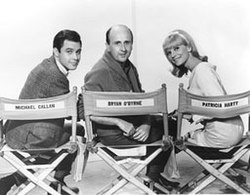Top Qs
Timeline
Chat
Perspective
Occasional Wife
American TV sitcom (1966–1967) From Wikipedia, the free encyclopedia
Remove ads
Occasional Wife is an American sitcom that aired on NBC from September 13, 1966 until August 29, 1967.[1][2]
Remove ads
Plot
Peter Christopher is a New York bachelor who enjoys the single life but is blocked in his professional advancement without a wife. Peter's boss, baby-food manufacturer Max Brahms, is a strong believer in marriage and family. Peter asks young hat check girl Greta Patterson to pose as his wife at company functions. In return, Peter rents Greta an apartment in his building. Greta uses the fire escape to slip into Peter's apartment whenever his boss visits unexpectedly. A man who lives on the floor between Peter's and Greta's apartments bemusedly watches them as they pass.
Remove ads
Cast
- Michael Callan as Peter Christopher[3]
- Patricia Harty as Greta Patterson[3]
- Jack Collins as Max Brahms[3]
- Stuart Margolin as Bernie[3]
- Chris Noel as Marilyn[3]
- Bryan O'Byrne as Man-in-the-Middle[3]
- Jack Riley as Wally Frick[3]
- Sara Seegar as Mrs. Christopher[3]
- Susan Silo as Vera[3]
- Joan Tompkins as Mrs. Brahms[3]
- Vin Scully as Narrator (uncredited)[1]
Callan and Harty married in 1968.[1]
Episodes
Remove ads
Production
Fred Freeman and Lawrence J. Cohen created the show. Ernst Pintoff was the director.[4] Harry Ackerman was the executive producer for the series, which was produced by Screen Gems in association with NBC.[5] Thirty episodes were filmed in color with a laugh track. Lever Brothers and Brown & Williamson were among the sponsors.[6]
The series was broadcast from 8:30 to 9 p.m. Eastern Time on Tuesdays.[3] It first experienced good ratings, tying at #18 with The Man from U.N.C.L.E. in the Nielsen ratings. The series then fell to #64 in the ratings after having to compete against ABC's popular series The Invaders and the CBS staple The Red Skelton Show. Occasional Wife was canceled after one season.[7]
Remove ads
Critical response
Jack Gould, writing in The New York Times, highlighted Harty's work, saying "she made a viewer more aware of what was right than wrong" with the show.[4] Noting that the story line was a "well-worn gambit", he complimented the creators and the director for dealing with it in a "warmly understated" way.[4] He added that Callan should become a "worthy foil" for Harty.[4] Gould ended his review by urging the ending of "stop-action camera nonsense, wherein an offstage narrator tries to be coyly amusing between scenes".[4]
Remove ads
References
External links
Wikiwand - on
Seamless Wikipedia browsing. On steroids.
Remove ads

